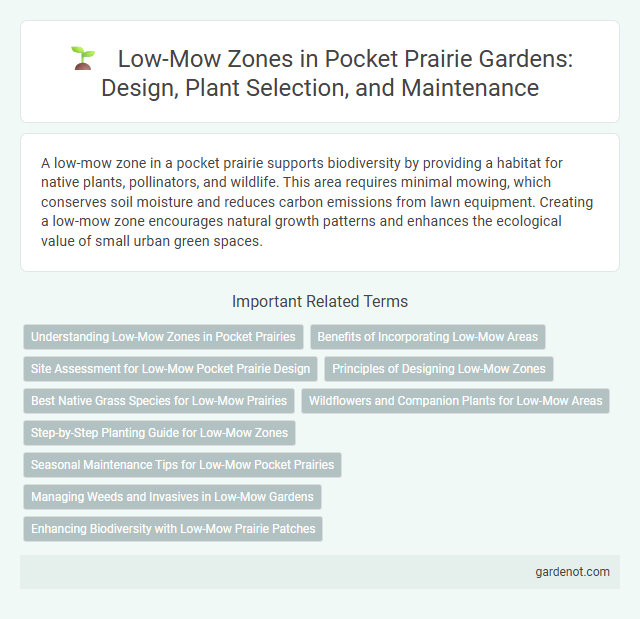A low-mow zone in a pocket prairie supports biodiversity by providing a habitat for native plants, pollinators, and wildlife. This area requires minimal mowing, which conserves soil moisture and reduces carbon emissions from lawn equipment. Creating a low-mow zone encourages natural growth patterns and enhances the ecological value of small urban green spaces.
Understanding Low-Mow Zones in Pocket Prairies
Low-mow zones in pocket prairies are designated areas where mowing is minimized to promote native plant growth and enhance biodiversity. These zones support pollinators and wildlife by providing essential habitats while reducing maintenance costs and soil erosion. Understanding low-mow zone management helps optimize ecological benefits and sustain thriving pocket prairie ecosystems.
Benefits of Incorporating Low-Mow Areas
Low-mow zones in a pocket prairie foster native plant diversity by allowing grasses and wildflowers to grow undisturbed, which supports pollinators like bees and butterflies. These areas enhance soil health by increasing organic matter and promoting beneficial microbial activity, leading to improved water retention and reduced erosion. Maintaining low-mow zones also reduces carbon emissions from mowing equipment and lowers maintenance costs, contributing to sustainable landscaping practices.
Site Assessment for Low-Mow Pocket Prairie Design
Site assessment for a low-mow pocket prairie design involves evaluating soil type, moisture levels, and sunlight exposure to select native plant species that thrive in minimal maintenance conditions. Understanding existing vegetation and drainage patterns helps optimize plant placement, promoting biodiversity and reducing invasive species risk. Accurate site analysis ensures a sustainable low-mow prairie that supports pollinators and enhances urban green space functionality.
Principles of Designing Low-Mow Zones
Low-mow zones in pocket prairies are designed to enhance biodiversity by minimizing mowing frequency, which supports native wildflowers and grasses. The principles include selecting native plant species adapted to local soil and climate conditions, establishing buffer zones to reduce disturbance, and scheduling mowings strategically to allow seed maturation and wildlife breeding. Properly implemented low-mow zones improve habitat quality, increase pollinator populations, and reduce maintenance costs.
Best Native Grass Species for Low-Mow Prairies
Big bluestem (Andropogon gerardii), little bluestem (Schizachyrium scoparium), and switchgrass (Panicum virgatum) are among the best native grass species for low-mow prairie zones due to their deep root systems and adaptability to minimal maintenance. These grasses enhance soil health by preventing erosion and supporting biodiversity, making them ideal for sustainable landscaping in pocket prairies. Establishing low-mow zones with these native grasses reduces the need for frequent mowing while promoting a resilient ecosystem.
Wildflowers and Companion Plants for Low-Mow Areas
Wildflowers such as Black-eyed Susan, Purple Coneflower, and Butterfly Weed thrive in low-mow zones, providing essential nectar sources for pollinators while requiring minimal maintenance. Companion plants like Little Bluestem and Prairie Dropseed enhance soil health and support biodiversity by creating habitat diversity in pocket prairies. Maintaining a low-mow regime encourages deeper root systems, improves drought resistance, and promotes a resilient native ecosystem.
Step-by-Step Planting Guide for Low-Mow Zones
Plant native grasses and wildflowers in low-mow zones to create a thriving pocket prairie that supports local biodiversity while reducing maintenance. Start by preparing the soil through light tilling and removal of invasive species, then evenly distribute seeds suited for your region's climate and soil type. Water the area consistently until seedlings establish, and gradually reduce watering to encourage deep root growth, enhancing drought tolerance and natural resilience.
Seasonal Maintenance Tips for Low-Mow Pocket Prairies
Seasonal maintenance for low-mow pocket prairies involves targeted mowing during late fall or early spring to remove dead plant material without disturbing root systems. Managing invasive species through spot treatments in early growing seasons promotes native prairie growth and biodiversity. Regularly monitoring soil moisture and adjusting irrigation ensures resilience during dry periods while supporting healthy native plant communities.
Managing Weeds and Invasives in Low-Mow Gardens
Low-mow zones in pocket prairies encourage native plant growth while suppressing invasive species through strategic mowing schedules that reduce seed dispersal and weaken weed establishment. Managing weeds and invasives in low-mow gardens involves timely mowing at heights above 8 inches, which preserves native perennials and disrupts invasive growth cycles. Implementing targeted spot treatments and manual removal further supports biodiversity by minimizing chemical use and promoting a resilient native ecosystem.
Enhancing Biodiversity with Low-Mow Prairie Patches
Low-mow prairie patches significantly enhance biodiversity by providing essential habitats for native pollinators and beneficial insects. These zones support a diverse range of wildflowers and grasses, promoting soil health and natural pest control. Maintaining reduced mowing frequency encourages plant species variety and creates refuges for wildlife in urban and suburban landscapes.
Low-mow zone Infographic

 gardenot.com
gardenot.com